In the coming decades, it is probable that the first steps will be made towards constructing human settlements on Mars. To look beyond the practical ‘grand challenge … of just getting to Mars and, hopefully, surviving for a few years’ (p.165), Justin Hollander invites us to make a leap of faith: ‘By making the assumption that we can get to Mars and survive there, the question driving this book is: when we do get there, how should we build cities?’ (p. 51). In the service of future human happiness and fulfilment, he calls for urban planning expertise to complement the contributions of ‘rocket scientists, geologists, chemists, food scientists, physicists, engineers and hydrologists’ (p. 208) in shaping this agenda.
After making an initial case for taking Martian urban planning seriously, the book provides some historical context. First, to derive initial principles for selecting and planning new settlements, Hollander presents a history of colonization on Earth. Chapter 3 then summarizes the history of space exploration, starting with the USSR’s Sputnik 1 satellite launch in 1957 and leading to what he calls a contemporary ‘Mars fever’ (p. 43). The next few chapters are thematically organized, reworking best practice planning and design principles to be applicable in Mars’ extreme environment. These cover the emotional needs of humans, transport, the interrelation of land uses, building design and materials, and resource infrastructure and recycling. More speculative accounts of space settlement are reviewed in Chapters 9 and 10, ranging from science fiction to more fully thought-out plans for habitations on the Moon and in orbit. The book ends by advancing an illustrative ‘template’ for a Martian city, drawing on a set of guiding principles aggregated from the previous chapters.
This is all conveyed with infectious enthusiasm. Nevertheless, one might question whether the book really meets its aim of outlining some first planning principles for Martian urbanization. I am concerned that, instead, it tends to promote an understanding of planning—often conflated here with urban design—as an apolitical, deterministic and rather singular endeavour. In contrast, planning theorists and historians typically highlight the geographical and historical diversity of its practices, governance arrangements and underlying ideologies, characterizing planning as an open-ended and multiple set of coexisting paradigms, shaped by varying political visions and normative framings. The issue is not that Hollander proceeds in ignorance of questions of shifting political or economic contexts: he is a trained architect and professor of urban and environmental policy. Rather, he deliberately brackets out such questions as barriers to constructive discussions about a future built environment. This strategy delineates the book’s aims more clearly, but I would still have liked to find a few more obvious caveats (and warnings) related to the social shaping of technology, the question of who will have the power to begin settling Mars, the implications of their motivations, and the path dependencies flowing from all this. It is difficult to imagine an ongoing process of Martian urban planning driven simply by benign cooperation or a collective love of adventure.
Relatedly, the book’s underpinnings would have been strengthened through some critical distance from Elon Musk’s views (which are mentioned only in passing, but more than once). This is an unfair criticism in the sense that its publication preceded Musk’s undignified descent into far-right populism, but Hollander still ignores a longer tradition of commentaries on the threats posed by tech moguls to democratic processes and social equity. A small detail, perhaps, but one which seems indicative of potential limits of the book’s appeal outside the pro-space community. Similarly, the treatment of colonization in Chapter 2 may be alienating for some readers. Hollander is at pains to acknowledge the darker aspects of colonialism on Earth—and this is to his credit when, remarkably, many advocates of space settlement fail to do so. He justifies using the term on the reasonable grounds that no humans will be adversely affected by extraterrestrial expansion—but this remains a reductive take on the idea of colonialism and its underlying mindset.
I would also have liked to find further interrogation of the ambition to build cities on Mars. Some use of urban theory might have allowed a more satisfactory explanation of this framing. Which aspects of ‘cityness’ would not be transferable to an extraterrestrial site? How should we account for the disorderly and dysfunctional aspects of urban life? The book does not concern itself, for example, with questions of crime and punishment. And yet, as astrobiologist Charles Cockell and others argue, there is a strong likelihood that outer space settlements would depend on more tyrannical forms of government than those generally acceptable on Earth. Such questions have a strong bearing on the principles underlying the forms of the built environment, and relate directly to the goals of happiness and human fulfilment guiding Hollander’s proposals.
So, who are the implied audiences of the book? Those already enthused by the idea of humans settling on Mars, and interested primarily in the technical challenges involved, will find a useful summary of existing knowledge, and should be encouraged to expand current thinking beyond questions of engineering and resource use. By arguing at the level of broad principles, rather than in arcane technical specifications, the book remains accessible for the curious general reader. There is joy in the book and humility: the conclusions present it as only a ‘baby step’ (p. 240) towards a more fully developed field of endeavour. Nevertheless, those more deeply engaged with critical debates on space exploration may well conclude that a raft of more foundational questions demands more urgent and sustained attention.
Robert Cowley, King’s College London
Justin B. Hollander 2023: The First City on Mars: An Urban Planner’s Guide to Settling the Red Planet. Sham, Springer Praxis
Views expressed in this section are independent and do not represent the opinion of the editors.

